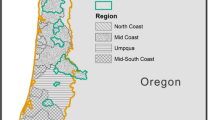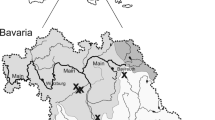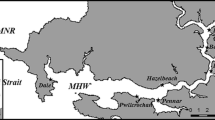Abstract
Introduced populations of Guekensia demissa occur on the west coast of North America. They have been reported in San Francisco Bay, four southern California wetlands, and in Estero de Punta Banda (EPB), Baja California Norte, Mexico. We randomly sampled benthic invertebrates in four habitat types within EPB: marsh, channel, mudflat and pan. Geukensia demissa was the most abundant bivalve in the wetland at EPB. It was significantly associated with the native cordgrass, Spartina foliosa, and occurred at higher average densities in vegetated marsh sites (24/m2) and Spartina-dominated tidal channels (35/m2), compared to mudflat (0/m2), and pan (0/m2) sites. We estimated that the total biomass of this invader was over four times that of the next most abundant bivalve, Tagelus spp., in EPB. We examined G. demissa for parasites and found that only a few native parasites colonized this introduced host at very low prevalences and intensities. We performed bird surveys to determine the habitat overlap and potential impact of this mussel on the EPB population of light-footed clapper rails (Rallus longirostrus levipes), an endangered species in the United States. The high abundance of G. demissa in EPB, its presence in clapper rail habitat, and its known effects on salt marsh habitat in it’s native range, warrant further investigations of the impact of this invader in EPB and elsewhere.
Similar content being viewed by others
References
RT Abbott (1974) American Seashells Van Nostrand Reinhold New York
E Baqueiro Cardenas R C Castillo M C Manuel Medina Maturel M Huchin (1993) ArticleTitlePotential pesquero del mejillon amarillo, Geukensia demissa, de las costas de los estados de Campeche y Yucatan, Mexico Ciencia Pesquera 9 63–72
MD Bertness (1980) ArticleTitleGrowth and mortality in the ribbed mussel Geukensia demissa The Veliger 23 62–69
MD Bertness (1984) ArticleTitleRibbed mussels and Spartina alternifloraproduction in a New England salt marsh Ecology 65 1794–1807
JT Carlton (1979) History, Biogeography, and Ecology of Introduced Marine and Estuarine Invertebrates of the Pacific Coast of North America University of California Berkeley 904
JT Carlton (1992) ArticleTitleIntroduced marine and estuarine mollusks of North America: an end-of-the-20th-century perspective Journal of Shellfish Research 11 489–505
AN Cohen JT Carlton (1995) Nonindigenous Species in a United States Estuary: A Case History of the Ecological and Economic Effects of Biological Invasions in the San Francisco Bay and Delta Region US Fish and Wildlife Service Washington, DC
DS Groot Particlede (1927) ArticleTitleThe California clapper rail: its nesting habits, enemies and habitat Condor 29 259–270
PE Fell NC Olmstead E Carlson W Jacob D Hitchcock G. Silber (1982) ArticleTitleDistribution and abundance of macroinvertebrates on certain Connecticut tidal marshes, with emphasis on dominant molluscs Estuaries 5 234–239
SE Ford KA Ashton-Alcox SA Kanaley (1995) ArticleTitleIn vitro interactions between bivalve hemocytes and the oyster pathogen Haplosporidium nelsoni(MSX) Journal of Parasitology 79 255–265
DR Franz (1997) ArticleTitleResource allocation in the intertidal salt-marsh mussel Geukensia demissa in relation to shore level Estuaries 20 134–148
DR Franz (2001) ArticleTitleRecruitment, survivorship and age structure of a New York ribbed mussel population (Geukensia demissa) in relation to shore level – a nine year study Estuaries 24 319–327
SE Ibarra-Obando M Poumian-Tapia (1991) ArticleTitleThe effect of tidal exclusion on salt marsh vegetation in Baja California, Mexico Wetlands Ecology and Management 1 131–148 Occurrence Handle10.1007/BF00177288
TE Jordan I Valiela (1982) ArticleTitleA nitrogen budget of the ribbed mussel, Geukensia demissa, and its significance in nitrogen flow in a New England salt marsh Limnology and Oceanography 27 75–90 Occurrence Handle1:CAS:528:DyaL38Xht12hurg%3D
DA Kreeger RIE Newell (2001) ArticleTitleSeasonal utilization of different seston carbon sources by the ribbed mussel, Geukensia demissa(Dillwyn) in a mid-Atlantic salt marsh Journal of Experimental Marine Biology and Ecology 260 71–91 Occurrence Handle10.1016/S0022-0981(01)00242-8 Occurrence Handle11358572
TJ Kwak JB Zedler (1997) ArticleTitleFood web analysis of southern California coastal wetlands using multiple stable isotopes Oecologia 110 262–277 Occurrence Handle10.1007/s004420050159
KD Lafferty AM Kuris (1996) ArticleTitleBiological control of marine pests Ecology 77 1989–2000
LA Levin TS Sinicrope Talley J Hewitt (1998) ArticleTitleMacrobenthos of Spartina foliosa(Pacific Cordgrass) salt marshes in southern California: community structure and comparison to a Pacific mudflat and a Spartina alterniflora(Atlantic Smooth Cordgrass) marsh Estuaries 21 129–144
BFJ Manly (1997) Randomization, Bootstrap and Monte Carlo Methods in biology EditionNumber2 Chapman and Hall London
KJ Nielsen DR Franz (1995) ArticleTitleThe influence of adult conspecifics and shore level or recruitment of the ribbed mussel Geukensia demissa (Dillwyn) Journal of Experimental Marine Biology and Ecology 188 89–98 Occurrence Handle10.1016/0022-0981(94)00190-O
DW Pritchard R Paz Vela Particlede La H Cabrera Muro S Farreras Sanz E. Morales (1978) ArticleTitleHidrografia fisica del Estero de Punta Banda parte I: Analisis de datos Ciencias Marinas 5 1–23
TS Sinicrope Talley SE Ibarra-Obando (2000) ArticleTitleTidal flat macrofaunal communities and their associated environments in estuaries of the Southern California and Northern Baja California, Mexico Estuaries 23 97–114
J Takekawa (1993) ArticleTitleThe California clapper rail: turning the tide? Tideline (East Bay Regional Park District) 13 IssueID1–3 11
ME Torchin KD Lafferty AP Dobson VJ McKenzie AM Kuris (2003) ArticleTitleIntroduced species and their missing parasites Nature 421 628–630 Occurrence Handle1:CAS:528:DC%2BD3sXovFKntA%3D%3D Occurrence Handle12571595
G Villareal-Chavez (1991) ArticleTitleImpacto de la construccion de un dique arenoso en la ecologia bentonica de un estuario en el pacifico norte de mexico Ciencias Marinas 17 105–119
JB Zedler CS Nordby BE Kus (1992) The Ecology of Tijuana Estuary, California: A National Estuarine Research Reserve NOAA Office of Coastal Resource Mangement Washington, DC
Author information
Authors and Affiliations
Corresponding author
Rights and permissions
About this article
Cite this article
Torchin, M.E., Hechinger, R.F., Huspeni, T.C. et al. The introduced ribbed mussel (Geukensia demissa) in Estero de Punta Banda, Mexico: interactions with the native cord grass, Spartina foliosa. Biol Invasions 7, 607–614 (2005). https://doi.org/10.1007/s10530-004-5851-5
Accepted:
Issue Date:
DOI: https://doi.org/10.1007/s10530-004-5851-5




